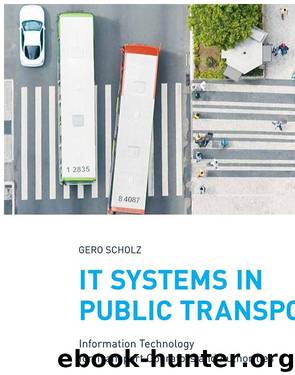IT Systems in Public Transport by Gero Scholz

Author:Gero Scholz
Language: eng
Format: epub
Publisher: dpunkt.verlag GmbH
Published: 2016-11-15T00:00:00+00:00
Fig. 8-2 Traffic jam and short turnaround
Headway regulation
The example shows the possibilities and limits of the inner/outer control circuit. The decision to turn at point C/C’ might have been taken by the driver himself – at least this is conceivable in non-railbound transport. But only the control centre is able to evenly distribute the vehicles on a new headway – provided it knows the position of all vehicles.
Monitoring connections
A second example for the outer control circuit is the monitoring of connections. Connections are defined in the planning and often also published in the timetable. Vehicles cannot make their own contribution to the monitoring of connections: the drop-off vehicle knows that he may have passengers on board who want to transfer at a certain point; if it is delayed, however, there is nothing left for it to do than to contact the control centre. As the control centre knows the vehicle’s timetable situation and monitors the connections anyway, this is not necessary.
Multistage control
Connection management is a very important central task. It is often carried out in several stages.
The control system automatically keeps the pick-up vehicle in place within a certain tolerance range until all of its drop-off vehicles have arrived. To do this, it communicates with the on-board computer, which gives the driver of the pick-up the corresponding information. You can even automatically activate standard announcements for the passengers ( “We are still waiting for delayed transfer passengers ...” ).
Download
This site does not store any files on its server. We only index and link to content provided by other sites. Please contact the content providers to delete copyright contents if any and email us, we'll remove relevant links or contents immediately.
Hit Refresh by Satya Nadella(9038)
The Compound Effect by Darren Hardy(8808)
Change Your Questions, Change Your Life by Marilee Adams(7635)
Nudge - Improving Decisions about Health, Wealth, and Happiness by Thaler Sunstein(7615)
The Black Swan by Nassim Nicholas Taleb(7010)
Deep Work by Cal Newport(6879)
Daring Greatly by Brene Brown(6445)
Rich Dad Poor Dad by Robert T. Kiyosaki(6401)
Principles: Life and Work by Ray Dalio(6209)
Man-made Catastrophes and Risk Information Concealment by Dmitry Chernov & Didier Sornette(5921)
Playing to Win_ How Strategy Really Works by A.G. Lafley & Roger L. Martin(5918)
Digital Minimalism by Cal Newport;(5664)
Big Magic: Creative Living Beyond Fear by Elizabeth Gilbert(5610)
The Myth of the Strong Leader by Archie Brown(5425)
The Slight Edge by Jeff Olson(5346)
Discipline Equals Freedom by Jocko Willink(5285)
The Motivation Myth by Jeff Haden(5156)
Stone's Rules by Roger Stone(5026)
The Laws of Human Nature by Robert Greene(4998)
